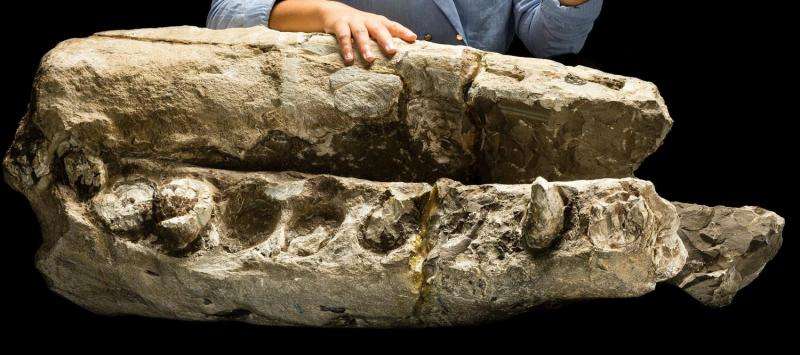Researchers re-analyze 15-million-year-old sperm whale fossil, find 'white whale'

A 15 million year-old fossil sperm whale specimen from California belongs to a new genus, according to a study published December 9, 2015 in the open-access journal PLOS ONE by Alexandra Boersma and Nicholas Pyenson from the Smithsonian's National Museum of Natural History.
The authors of the study reanalyzed the large but incomplete Ontocetus oxymycterus fossil sperm whale specimen from the middle Miocene Monterey Formation of California, originally described in 1925 by Remington Kellogg. Kellogg put this species in the genus Ontocetus, that was originally thought to be a tooth taxon; however, it is now known that in this genus, species have walrus tusks instead of a cetacean teeth. Thus, the authors assigned this species to the new genus Albicetus, creating the new combination of Albicetus oxymycterus, gen. nov. The authors used the term "Albicetus," or "white whale," because they were inspired by the fossil's bone-white color, in homage to Melville's famous fictitious leviathan Moby Dick.
The authors also analyzed whale's body size in comparison to the sperm whale evolutionary tree. Kellogg originally placed this species in the genus Ontocetus, an enigmatic tooth taxon reported from the 19th century. However, whales of large body size likely arose multiple times in the evolution of sperm whales, and the majority of these large whales also had unusually large upper and lower teeth. The authors suspect that the presence of big teeth in fossil sperm whales may suggest that they were feeding on large prey, perhaps marine mammals such as seals and other smaller whales as opposed to modern sperm whales, which feed primarily on squid, hardly using their teeth for chewing.
"This find means that, around 15 million years ago when there were a lot of large sperm whales with big teeth like Albicetus, it may have been a moment of peak richness in the number and diversity of marine mammals serving as prey to these whales," Boersma suggests.

Journal information: PLoS ONE
Provided by Public Library of Science





















